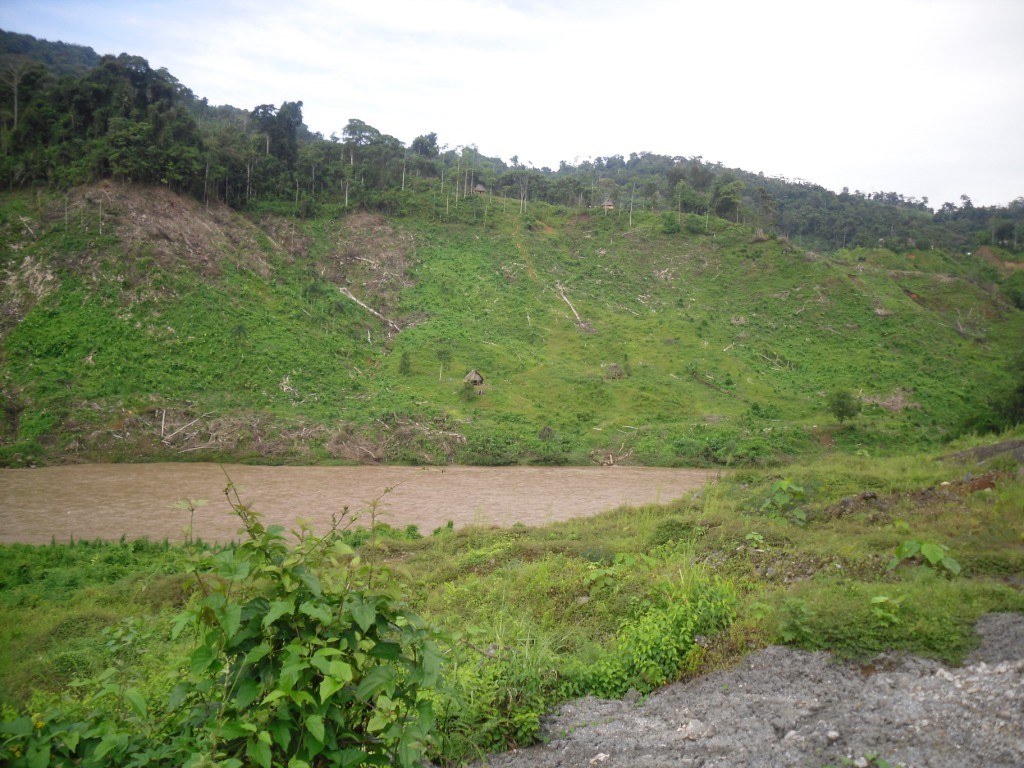The location of the dam is the Palo Seco Protected Forest within the La Amistad Biosphere Reserve, in the province of Bocas del Toro, Panamá. The La Amistad Biosphere Reserve, part of the Mesoamerican Biological Corridor, is a UNESCO World Heritage Site which is shared with Costa Rica. In 2008, the discoveries of three new species of salamanders were reported, found on the Costa Rican side of the Reserve very close to the Panamanian border.[1] Many environmentalists fear that the impacts of the Chan-75 project will be “manifold and immeasurable for the biologically rich ecosystems”[2] found in the Reserve, as the project will include a 1,400 hectare reservoir in “what is known to be Central America’s largest remaining expanse of untouched rainforest.”[3] Large-scale deforestation has already occurred.
Furthermore, the Changuinola River drains into an internationally recognised wetland, called the San San – Pond Sak Wetlands.[4] The construction of the dam means that many streams will be depleted, and there are concerns that the natural migratory patterns of fish will be altered due to changes in the level and quality of the water. According to Bill McLarney, “the effects upstream and downstream from the dams would be drastic, possibly involving the extirpation of eight to ten species of migratory fish and several species of shrimps.”[5] This will cause serious problems for the indigenous Ngöbe people whose main source of protein comes from the fish in this river system.
The construction of the Chan-75 dam will result in the relocation of 178 households from four communities: Charco La Pava, Valle del Rey, Guayabal and Changuinola Arriba. It is estimated that over 2,500 people live in the impact zone and will be affected in one way or another.[6] Although AES Changuinola promotes a process of “Participative Resettlement”[7] and has documented hundreds of meetings and support sessions with the indigenous population, the fact remains that free, prior and informed consent was not sought before the beginning of the project. This is classed as a violation of human rights by international standards, especially as the Ngöbe communities are regarded as vulnerable due to their lack of land tenure and reliance on natural resources.[8] Since construction work started on the dam the Ngöbe have experienced excessive noise well into the night, the generation of dust from heavy machinery and a decreased quality of water in the river that they depend on. They also live in an environment of fear and insecurity. There have been reports that Ngöbe people have been pressured to sign away their land on documents written in Spanish, a language that many Ngöbe are unable to read or speak.[9],[10] Peaceful protests have been violently repressed, and petitions against the construction of the dam have been ignored. In March 2008, two NGOs presented a petition to the Inter-American Court of Human Rights (IACHR) in an attempt to halt the construction of the dam while an investigation into the human rights breaches against the Ngöbe is carried out. As a result, in 2009, the IACHR called for the suspension of all activities related to the Chan-75 dam, although this ruling has been in vain as the Panamanian government continues to permit the construction of the dam.[11]
[1] BBC News (2008) Bio-rich Costa Rica’s new marvels, BBC http://news.bbc.co.uk/2/hi/science/nature/7170205.stm (Accessed 22/09/2010).
[2] Monti Aguirre (2007) Dams Threaten Biodiversity and Indigenous People in Panama, World Rivers Review, Vol. 22, No. 4, P.6.
[3] Mireille Gold (2007) Hydroelectric Dams vs. Nature & Tradition, Mesoamerica, Nov 2007, P.11.
[4] Osvaldo Jordan and Peter Galvin (2008) ACD Comments on Changuinola 1 (Chan-75) Large Hydro Project (Panama), Alliance for Conservation and Development (ACD) and the Centre for Biological Diversity http://www.internationalrivers.org/en/global-warming/the-cdm-kyotos-carbon-offsetting-scheme/acd-comments-changuinola-1-chan-75-large-hydr (Accessed 22/09/2010).
[5] Bill McLarney (2007) Director of the Stream Biomonitoring Programme at the Asociación ANAI in Costa Rica, Cited in Monti Aguirre – see Note 2.
[6] H. González (2009) General Manager of AES Changuinola, Cited in Mary Finley-Brook and Curtis Thomas (2010) Treatment of Displaced Indigenous Populations in Two Large Hydro Projects in Panama, Water Alternatives, Vol. 3, No. 2, P.269 – 290.
[7] AES Changuinola (2008) Participative Resettlement, AES http://www.aeschanguinola.com/eng/resettlement.asp (Accessed 22/09/2010).
[8] James Anaya (2009) Informe del Relator Especial sobre la situación de los derechos humanos y las libertades fundamentales de los indígenas: Observaciones sobre la situación de la comunidad Charco la Pava y otras comunidades afectadas por el proyecto hidroeléctrico Chan 75 (Panamá), Report presented to the Human Rights Council at the UN General Assembly, 7 Sept 2009.
[9] Cultural Survival (2010) Panamanian Government Steps Up Dam Construction on Ngöbe Lands, Cultural Survival http://www.culturalsurvival.org/news/panama/panamanian-government-steps-dam-construction-ng-be-lands (Accessed 23/09/2010).
[10] Cultural Survival (September 2010) ‘Dam Nation’, www.culturalsurvival.org/current-projects/%5Bfield_program-raw%5D/dam-nation (Accessed 22 September 2010).
[11] Op.cit. (Cultural Survival, 2010).
